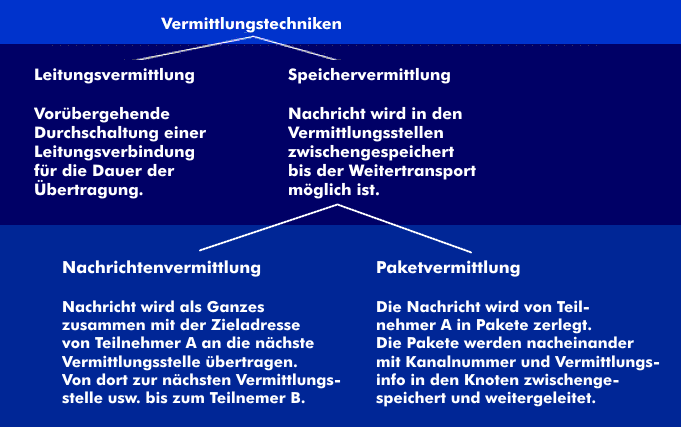packet switching exchange (PSE)
Packet switching exchange (PSE) is an asynchronous time division multiplex. In this switching technique, messages are switched in packets using the store-and-forward method or the cut-through method over partial distances from one network node to the next. Data packet switching forms the basis for data packet networks. A distinction is made between two methods: single packet switching and channel switching.
Single packet switching
In single packet switching, each packet is equipped with a header that contains all the information relevant to switching. This is the address information of the recipient and sender, notes on sending, routing information and notes to the recipient. The messages to be transmitted are divided into several data packets. At the receiver, the individual data packets are reassembled to form the original data stream.
In single-packet switching, each data packet is transmitted individually in loose sequence and reassembled into a complete message by the receiving station. While in cut-through switching the data packet is forwarded directly as soon as the switch has detected the destination address, in memory switching the data packets are temporarily stored in a buffer andchecked. Only then is forwarding carried out.
During data packet transmission, it can happen that the sequence of the received data packets is incomplete and mixed up, due to data packet losses, overtaking of data packets and unintentional duplication. This requires special measures to be implemented in the protocols. This type of connection is also called connectionless service( CLNS).
The channel technique
The second type of switching is channel technology. Here, virtual connections are formed using logical channels. In this method, there is a packet map with all addresses, special features, routing information, etc., transmitted in the CALL packet.
In data packet switching, in contrast to circuit switching, the transmission paths are not used exclusively; this is why it is referred to as virtual connections( VC). The data packet switching principle distinguishes two types of virtual connections: the fixed virtual connection( PVC) and the dialed virtual connection(GVV).
In data packet switching, the transmission bandwidth is requested on a demand basis and can be made available to several logical connections simultaneously.
Standards for data packet switching
The principle of data packet switching is defined in various standards. One of the oldest standards for data packet switching is described in the ITU-T recommendationX.25 and represents an economical solution for the international exchange of data. In addition to the X.25 recommendation, the ISO standardsIS 7776 and IS 8208 as well as the DIN standards DIN 66221 and 66222 exist on this subject. The different recommendations, standards and norms agree in essential points, they only differ in the approach to standardization. The ITU-T describes data packet switching on the basis of network behavior, the International Standards Organization (ISO) and DIN on the basis of terminal behavior. A further development of data packet switching is cell switching.

